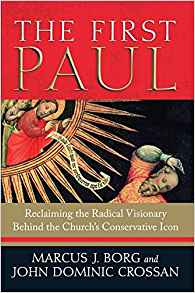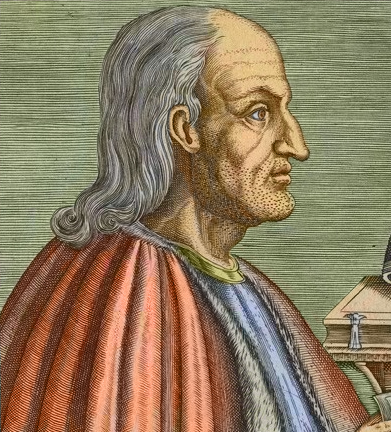Updated 8th June with postscript
Dr James McGrath has an interesting take on Joseph of Arimathea in that he interprets his first appearance in the gospel record as one of the many Jews who were responsible for the crucifixion of Jesus — and his burial. Only in subsequent gospel narratives is his character evolved into that of a disciple of Jesus.
I like this view because it adds some detail to my own understanding of the role of Joseph of Arimathea in Mark, as spelled out in earlier posts:
- Jewish Scriptures in Mark
- The post-70 c.e. provenance of the tomb metaphor
- The mocking of Joseph and Pilate in Mark
James McGrath in The Burial of Jesus: History & Faith is addressing a very different audience from any of my posts. My overall impression is that he is writing for believers who generally have a black and white (fundamentalist) understanding of the Bible and their faith, and is attempting to gently lead them to open their minds to the validity of interpretations of the Bible that (faith-based) scholarship opens up. The “historical methods” he discusses as tools of analyzing the texts of the gospels are, as far as I am aware, methods used almost exclusively among biblical scholars (not among historians per se) and that are expected to carry such heavy weights of “probable proofs” for the occurrence of certain facts. If I am mistaken I would appreciate being better informed.
Those for whom I imagine myself writing, on the other hand, are fellow amateur explorers of the origins and natures of the texts and faith that has been so pivotal in shaping our culture and minds, and to do so with the aid of secular historical and literary tools. And though amateur, I do feel I have advantages that enable me to introduce to general audiences some of the findings found in otherwise hard-to-access scholarly books and journals.
I also see that James McGrath has a new book coming out, The Only True God: Early Christian Monotheism in its Jewish Context. I’m still working through notes on Margaret Barker, Charles Talbert and in particular most recently John Ashton (Understanding the Fourth Gospel) and others that flesh out the complexities of Jewish religious beliefs pre 70 c.e. and that our canonical texts attempt to hide. Looking forward to catching up on The Only True God, too.
So back to this particular discussion of Joseph of Arimathea
Mark 15
[42] And now when the even was come, because it was the preparation, that is, the day before the sabbath,
[43] Joseph of Arimathaea, an honourable counseller, which also waited for the kingdom of God, came, and went in boldly unto Pilate, and craved the body of Jesus.
[44] And Pilate marvelled if he were already dead: and calling unto him the centurion, he asked him whether he had been any while dead.
[45] And when he knew it of the centurion, he gave the body to Joseph.
[46] And he bought fine linen, and took him down, and wrapped him in the linen, and laid him in a sepulchre which was hewn out of a rock, and rolled a stone unto the door of the sepulchre.
[47] And Mary Magdalene and Mary the mother of Joses beheld where he was laid.
Two points here, especially if read casually with the parallel narratives in the other gospels in mind, can lead to the impression Joseph was doing a Good Thing as a would-be disciple of Jesus. Mark describes him as “an honourable counseller” and one who “also waited for the kingdom of God.”
As McGrath points out, though, all “good Jews”, not only followers of Jesus, “waited for the kingdom of God.”
McGrath may have also been implying that one needs only compare Jesus’s hostile debates with other honourable figures in the Jewish community, one of whom he could say, “You are not far from the kingdom of God”, to recall that being an honourable pillar in Jerusalem, and not being far from the kingdom, left one as far removed from salvation as the rich man who was also loved by Jesus but who departed very sorrowfully to realize he could not enter. So close, yet so far. (See Mark 10-13)
McGrath points to the reason for the introduction of Joseph at this point. It was to ensure the observance of the sabbath. Thus the reason Mark gives for Joseph’s act has nothing to do with devotion to Jesus, but is all about religious scruples. Compare Josephus’ words in his Jewish War 2.5.2 (2.317):
. . . although the Jews used to take so much care of the burial of men, that they took down those that were condemned and crucified, and buried them before the going down of the sun.
(I am increasingly fascinated at how much of the historical background to the earliest gospel is echoed in with as much or as little adornment as found in Josephus. But let’s stick to this topic for now.)
If we read this account within the parameters of the rest of Mark alone (that is, not through the eyepieces of later gospels), then it is a logical exposition to read Joseph acting with the same attention to law-abiding godliness as the Pharisees, the chief priests and other leaders had been diligent throughout the gospel to enforce the strict observance of the sabbath, to avoid a trial and execution during the feast, and the requirement for due process (two or more witnesses). By the time the reader is has followed the narrative up to near the final chapter of this gospel, she is surely expected to know that ritual-law-observance is to be equated with the old wineskins, with blindness, and with enmity against Jesus. This has, after all, been a dominant message from the earliest chapters.
McGrath tellingly notes that Joseph acted apart from the followers of Jesus who were present. He presumably had his servants wrap the body and lay it in the tomb while the women who had followed Jesus stood back as bystanders. Such a scene raises very awkward questions if the reader was meant to think of Joseph as having sympathies with Jesus’ followers. Joseph does not involve them at all. And Joseph does nothing more than the bare minimum to get the body down from the cross and into a tomb before sunset in order to comply with the sabbath law.
I like to add another allusion I suspect Mark was directing at his original readers. McGrath sees Joseph’s waiting for the Kingdom of God as saying little more than he was a typically devout Jew of the time. I think Mark meant more than that here. The narrative surrounding Joseph’s request is strongly focussed on the surprising fact of the unexpected suddenness of Jesus’ death. Pilate marvelled at the news from Joseph, and felt compelled to confirm it through his centurion.
Just as the disciples had been caught out unprepared when Jesus was taken in Gethsemane, so do the Roman Pilate and centurion, and the Jewish counsellor Joseph, find themselves having to address the suddenness of Jesus’ death on the cross. Jesus had warned in his famous Olivet Prophecy that all were to be on guard and watch, for they knew not when the day would come. The only ones who were/are aware of the day of the Lord are the readers, the insiders. No-one in the narrative knows that Jesus made his “exodus” after the earth had been in supernatural darkness for three hours, and from that time on the old order was overthrown (note the tearing of the temple veil). The women, like Joseph, are just as blind and mindful of the things (the flesh) of this world when they return to the tomb to anoint a dead body.
They were all waiting for the kingdom. But they had all missed it when it was ushered in through the mock Roman Triumph (See Schmidt’s Jesus Triumphal March to Crucifixion).
If Mark did take his imagery for the crucifixion scenes from the Jewish Scriptures, in particular from Isaiah, as is widely believed, then we have further reason to think that all the above was indeed in the forefront of his mind, and that he was deliberately introducing a character to fulfil the following:
And they made his grave with the wicked —
But with the rich at his death. . . . (Isaiah 53:9)
Similarly, the tomb being described as a hewn rock is a metaphor for the destruction of the Temple for the sins of the nation in an earlier passage in Isaiah
. . . you have hewn a sepulchre here,
as he who hews himself a sepulchre on high,
who carves a tomb for himself in a rock . . . . (Isaiah 22:16 — same Greek words in both Mark and LXX for ‘carved/hewn’ and ‘tomb’ and ‘rock’)
The texts from which Mark’s gospel drew for his scenes of entombment in a carved out rock are laden with motifs of the wickedness of Jerusalem. This is also surely suggestive of how to interpret Mark, here.
Comparing Matthew
Matthew 27
[57] When the even was come, there came a rich man of Arimathaea, named Joseph, who also himself was Jesus’ disciple:
[58] He went to Pilate, and begged the body of Jesus. Then Pilate commanded the body to be delivered.
[59] And when Joseph had taken the body, he wrapped it in a clean linen cloth,
[60] And laid it in his own new tomb, which he had hewn out in the rock: and he rolled a great stone to the door of the sepulchre, and departed.
[61] And there was Mary Magdalene, and the other Mary, sitting over against the sepulchre.
McGrath here points out the earliest signs of Josephs’ transformation and a deliberate departure from Mark’s account. Matthew has removed Joseph from the council that condemned Jesus, and describes him rather as a rich man who could afford his own tomb. But more than that, of course, Matthew directly calls him a disciple.
Other noteworthy changes McGrath draws attention to are the emphasis on the cleanliness of the cloth and that fact that the tomb was a new one. The tomb was not only a new one, but it was that of Joseph himself. There can thus be no doubt that it had been used for any other corpse.
McGrath sees historical similitude here. Mark’s narrative could be interpreted as Joseph doing a rush job to get Jesus into a tomb as quickly as possible, with the assumption that he used a tomb large enough for several bodies and that was positioned near the crucifixion site for just this purpose — disposing of crucified bodies quickly when required.
He still has not been able to bring the women into the action, however. McGrath sees this as a clue that Matthew really was not a disciple and that this fact is given away by his omitting to include the women in the act of burial. I think a far simpler explanation is that Matthew still needs to have a good reason to get the women to the tomb the next day after the sabbath, so he is reserving them for that moment. Or if Joseph himself did not actually participate in the burial, but his servants only, as McGrath suggests, then why not also allow for the women to refrain from defiling themselves on the sabbath eve? Or Matthew is taking the trouble to re-write those portions that he feels necessary to present a more favourable picture of Joseph of Arimathea. They women’s turn will come next. To assume historicity machinations at work in the mind of the author seems to me to be adding unfounded complexities upon unfounded assumptions.
Comparing Luke
Luke 23
[50] And, behold, there was a man named Joseph, a counseller; and he was a good man, and a just:
[51] (The same had not consented to the counsel and deed of them😉 he was of Arimathaea, a city of the Jews: who also himself waited for the kingdom of God.
[52] This man went unto Pilate, and begged the body of Jesus.
[53] And he took it down, and wrapped it in linen, and laid it in a sepulchre that was hewn in stone, wherein never man before was laid.
[54] And that day was the preparation, and the sabbath drew on.
[55] And the women also, which came with him from Galilee, followed after, and beheld the sepulchre, and how his body was laid.
Luke retains Joseph’s counseller status, but adds the unambiguous “he was a good man and just”, and that he “had not consented to the counsel” to crucify Jesus. Again, like Matthew, however, he stresses the fact that the tomb was not a mass deposit for crucified bodies. It was new, uncorrupted. Like Matthew, Luke was stressing that Jesus was not dumped in a common dug out for crucified criminals.
Comparing John
John 19
[38] And after this Joseph of Arimathaea, being a disciple of Jesus, but secretly for fear of the Jews, besought Pilate that he might take away the body of Jesus: and Pilate gave him leave. He came therefore, and took the body of Jesus.
[39] And there came also Nicodemus, which at the first came to Jesus by night, and brought a mixture of myrrh and aloes, about an hundred pound weight.
[40] Then took they the body of Jesus, and wound it in linen clothes with the spices, as the manner of the Jews is to bury.
[41] Now in the place where he was crucified there was a garden; and in the garden a new sepulchre, wherein was never man yet laid.
[42] There laid they Jesus therefore because of the Jews’ preparation day; for the sepulchre was nigh at hand.
Now Joseph of Arimathea is not only a disciple, but a secret one. And not only a secret disciple, but a companion of Nicodemus who had also come to Jesus secretly by night.
Not only does John here concede that the tomb was close by the area of crucifixion, and thus otherwise potentially a common grave for criminals, but stresses once again that the sepulchre was both new and that it had never yet contained a body.
And since John is about to rewrite the easter morning narrative by removing the group of women coming to anoint Jesus’ corpse, he has instead both Joseph and Nicodemus wrapping the body of Jesus with a hundred pounds of spices.
So what was wrong with Mark’s narrative?
Why did the subsequent evangelists find so much to change about Mark’s account of Joseph of Arimathea?
McGrath’s explanation is plausible at one level: Mark’s stark account left open the interpretation that the tomb was a common one for crucified criminals, and that Joseph himself was not necessarily any more venerable than any other law-abiding Jewish leader.
Later evangelists might understandably have re-written Mark’s ending in a number of ways to give it a more exultant and joyful finale. This meant adding resurrection appearances to the disciples, and allowing the women to see the resurrected Jesus, too. It also meant reverentially treating the body of Jesus with the hands of a good man and just, those of none other than a secret disciple of Jesus.
The reason they did this was to cover up the embarrassment of Jesus being left to be buried by a non-follower, and possibly even in a common grave for criminals.
McGrath sees at work here the criterion of historical embarrassment, or embarrassment over a fact that could not be denied. The fact that later evangelists attempt to hide the “facts” as suggested by Mark is evidence for the general historicity of Mark’s account.
I have to disagree. First question that the above scenario raises is, Why did the supposed attempts to hide the historical facts only appear to begin with the gospel authors subsequent to Mark?
If the fact was both undeniable and embarrassing, and if there had been decades of oral transmission before the first gospel was penned, surely one would expect the “cover up” or “revisionist versions” to have begun before any of the gospels came to be written.
But what we do find is that with the first evidence of this narrative in Mark’s gospel, we see the possibility of coherently interpreting the details (through the context of earlier narratives and sayings in the same gospel) in such a way as to give the Joseph of Arimathea anecdote a theological function that is consistent with earlier sayings and episodes in that gospel. All the faithless come together at the end: Pilate and the centurion, the Jewish mob and the Jewish leader, the women and reference to the disciples. They have all missed the end of this present age and the ushering in of the new with the paradoxical exaltation of Christ. Only the readers understand the meaning of all these events along with the darkness at noon and the tearing apart of the Temple veil.
What embarrassed later gospel author’s was Mark’s narrative. They were also embarrassed by his Jesus who only became a son of God at his baptism when possessed by the Spirit, and the total failure of his disciples. The embarrassment is not with history, but with the theological messages of the first written gospel.
I thank Dr James McGrath for raising his view of Joseph of Arimathea in an earlier post of mine and giving me the opportunity to read his views. It is nice to read where others have also trodden views that have been similar to mine, and to learn new details, despite differences at other levels of interpretation.
P.S. — added 8th June:
John the Baptist was buried by his disciples. I suspect we have here enough incentive for certain Christian schools or factions to have their leader likewise buried by a devotee, even if necessarily in secret.
Like this:
Like Loading...








